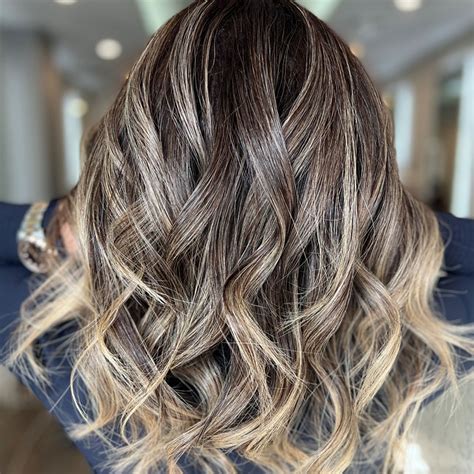Balayage: A Freehand Painting for Seamless Results
Balayage is a French hair coloring technique that translates to “to sweep” or “to paint.” It involves hand-painting color onto the hair, creating a natural-looking, sun-kissed effect. Unlike traditional highlighting, balayage is applied freehand without the use of foils or a cap, allowing for more customized and artistic results.

- Benefits of Balayage:
- Creates a natural-looking, beachy effect.
- Low-maintenance, requiring fewer touch-ups than traditional highlights.
- Can be customized to suit any hair color and texture.
- Adds depth and dimension to hair, making it appear fuller.
Step-by-Step Guide to Balayage:
- Section the hair: Divide the hair into small, manageable sections.
- Lighten the hair: Using a lightener, apply it to the desired sections following the balayage technique (sweeping color).
- Tone the hair: After the hair has been lightened, apply a toner to blend the colors and neutralize any unwanted warmth.
- Style and finish: Style the hair as desired, adding products to enhance the color and shine.
Highlights: A Precision Approach for Defined Results
Highlights are another popular hair coloring technique that involve selectively lightening strands of hair to create a contrasting effect. Unlike balayage, highlights are applied using foils or a cap, isolating specific sections of hair and resulting in a more defined, geometric look.
- Types of Highlights:
- Foil Highlights: Applied using foil sheets that are folded around the selected sections of hair.
- Cap Highlights: Applied using a plastic cap with holes, through which the hair is pulled and then lightened.
- Babylights: Very fine, subtle highlights that create a soft, natural-looking effect.
Step-by-Step Guide to Highlights:
- Section the hair: Divide the hair into smaller, manageable sections.
- Place foils or cap: Depending on the desired technique, place foil sheets or a cap over the sections to isolate the hair.
- Lighten the hair: Apply lightener to the exposed sections of hair, following the desired pattern for the highlights.
- Tone the hair: After the hair has been lightened, apply a toner to blend the colors and neutralize any unwanted warmth.
- Remove foils or cap: Gently remove the foils or cap and rinse the hair thoroughly.
- Style and finish: Style the hair as desired, adding products to enhance the color and shine.
Choosing Between Balayage and Highlights: A Decision for Your Style
The choice between balayage and highlights depends on the desired hair transformation.
- Balayage: Ideal for those seeking a natural-looking, sun-kissed effect with low maintenance.
- Highlights: Suitable for those preferring a more defined, geometric look with greater color contrast.
Cost Comparison: Balayage vs. Highlights
The cost of balayage and highlights can vary depending on the salon, stylist, hair length, and desired result.
- Balayage: Typically ranges from $120 to $300, with additional costs for any additional services (e.g., toner, treatment).
- Highlights: Typically ranges from $100 to $250, with additional costs for any additional services.
Caring for Balayage and Highlights: Maintenance Tips
- Use color-protecting shampoo and conditioner: These products help seal in color and prevent fading.
- Limit washing: Over-washing can strip the hair of its natural oils and cause color to fade faster.
- Protect from heat: Use heat protectant products when styling to prevent color damage.
- Refresh color regularly: Touch-ups may be necessary every 4-8 weeks to maintain vibrant color and blend regrowth.
Trendy Variations: Modern Applications of Balayage and Highlights
Balayage and highlights are continually evolving, with new techniques and variations emerging:
- Bronde Balayage: A combination of blonde and brown tones for a warm, sun-kissed look.
- Reverse Balayage: Darkening the roots and gradually lightening the hair towards the ends, creating a more dramatic effect.
- Copper Balayage: Incorporating copper tones into the balayage for a fiery, auburn-inspired result.
- Chunky Highlights: Bold, chunky sections of highlights for a statement-making look.
Tables:
Table 1: Balayage vs. Highlights: Comparison
| Feature | Balayage | Highlights |
|---|---|---|
| Technique | Freehand painting | Isolated sections using foils or cap |
| Results | Natural, sun-kissed effect | Defined, geometric look |
| Maintenance | Low-maintenance | Requires more frequent touch-ups |
| Cost | Typically higher | Typically lower |
Table 2: Benefits of Balayage and Highlights
| Technique | Benefits |
|---|---|
| Balayage | Natural-looking, low-maintenance, customizable, adds depth and dimension |
| Highlights | Defined results, geometric look, greater color contrast |
Table 3: Cost Comparison: Balayage vs. Highlights
| Technique | Cost Range |
|---|---|
| Balayage | $120 – $300 |
| Highlights | $100 – $250 |
Table 4: Caring for Balayage and Highlights: Maintenance Tips
| Tip | Description |
|---|---|
| Color-protecting products | Seal in color, prevent fading |
| Limit washing | Avoid stripping natural oils, preserve color |
| Heat protection | Prevent color damage during styling |
| Regular touch-ups | Maintain vibrant color, blend regrowth |
